📞+86 153 7530 2641 📧 hongjing.Wang@feichuncables.com

Type R-(N)TSCGEWOEU-FO Reeling Crane Cable for Port Cranes, Ship Unloaders, and Reclaimers
Discover the high-performance Type R-(N)TSCGEWOEU-FO reeling crane cable, specially engineered for port cranes, ship unloaders, and reclaimers. With fiber optic elements and superior mechanical durability, this heavy-duty crane cable ensures reliable power and data transmission in harsh port environments.
hongjing.Wang@Feichun
7/28/20259 min read
Introduction: Crane Cables in Port and Harbor Applications
Modern port operations represent one of the most demanding environments for electrical infrastructure. The constant movement of massive cranes, ship unloaders, and reclaimers requires cables that can withstand extreme mechanical stress while maintaining reliable power transmission and data communication. In these critical applications, cable failure isn't just an inconvenience—it can result in costly operational downtime, safety hazards, and significant economic losses.
The importance of reliable reeling cables for cranes, ship unloaders, and reclaimers cannot be overstated. These systems operate continuously in harsh marine environments, subjected to salt spray, temperature fluctuations, mechanical vibration, and constant flexing as they move along their operational paths. Traditional cable solutions often fall short of meeting these demanding requirements, leading to frequent replacements and maintenance interventions.
Today's port facilities increasingly demand integrated power and data transmission solutions that can handle the sophisticated control systems required for modern automated operations. The growing need for real-time monitoring, automated positioning systems, and remote diagnostics has created a market demand for cables that can simultaneously carry high-voltage power and high-speed data signals without interference or degradation.
Container terminals, bulk material handling facilities, and shipyards all rely on these specialized cable systems to maintain their competitive edge in global commerce. As ports continue to modernize and automate their operations, the selection of appropriate reeling cable systems becomes increasingly critical to operational success.
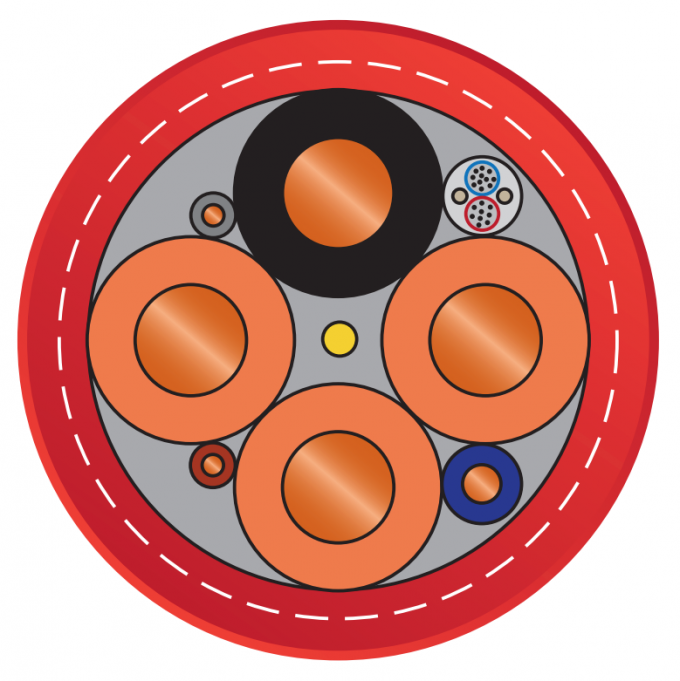

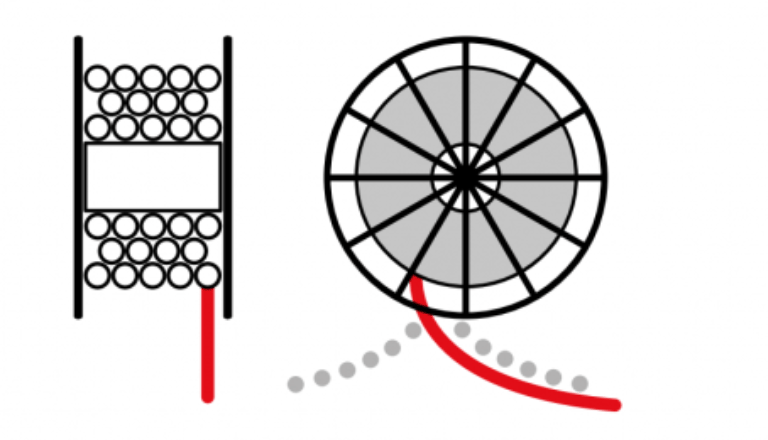

Overview of Type R-(N)TSCGEWOEU-FO Reeling Crane Cable
The Type R-(N)TSCGEWOEU-FO represents a breakthrough in reeling crane cable technology, specifically engineered to meet the unique challenges of port and harbor applications. Understanding the cable's nomenclature provides insight into its sophisticated design: the "R" designation indicates its suitability for reeling applications, while "TSCGEWOEU" represents the specific conductor arrangement and insulation system optimized for dynamic stress resistance.
The "-FO" suffix indicates the integration of fiber optic elements, making this a hybrid power and communication cable that addresses modern port automation requirements. This designation follows international standards for cable classification, ensuring compatibility with existing port infrastructure and maintenance protocols.
Key technical features of this advanced cable system include voltage ratings from 3.6/6.0 kV up to 12.0/20.0 kV, making it suitable for high-power crane applications. The cable demonstrates exceptional temperature resistance, maintaining flexibility and performance across a wide operational range from -25°C to +80°C during flexing operations, and capable of withstanding storage temperatures from -40°C to +80°C.
The insulation system utilizes advanced polymer compounds specifically formulated for marine environments, providing superior resistance to moisture, salt spray, and chemical contaminants commonly found in port operations. The outer sheathing incorporates materials designed to resist abrasion, cutting, and tearing while maintaining flexibility under dynamic loading conditions.
The conductor design features tinned copper construction with optimized strand configuration to minimize work hardening and fatigue failure during the millions of flex cycles expected in typical crane operations. The maximum permissible tensile force of 1350N ensures the cable can handle the mechanical stresses encountered during normal operation while maintaining electrical integrity.
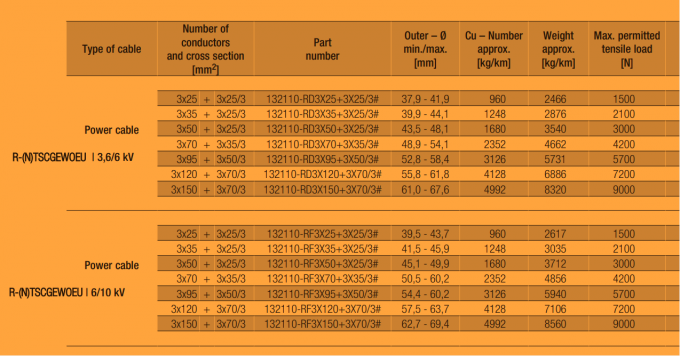

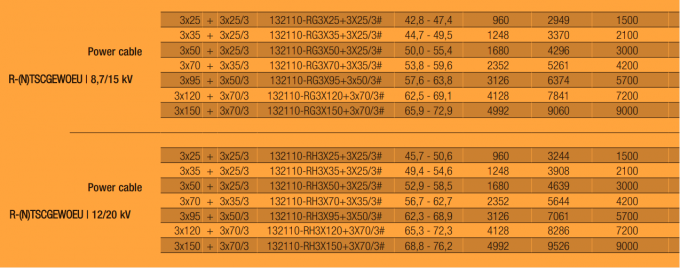

Fiber Optic Integration: Power + Data in One Cable
The integration of fiber optic elements within the Type R-(N)TSCGEWOEU-FO cable represents a significant advancement in crane cable technology. Traditional port operations required separate power and communication cables, creating installation complexity, increased maintenance requirements, and potential failure points. The built-in fiber optics eliminate these concerns while providing superior communication capabilities.
Benefits of integrated fiber optics in crane operations extend far beyond simple cable consolidation. Fiber optic communication offers immunity to electromagnetic interference, which is particularly important in port environments where large motors, variable frequency drives, and high-power electrical systems create significant electrical noise. This immunity ensures reliable data transmission even in the most electrically hostile environments.
The fiber optic elements enable high-speed communication between crane control systems, supporting real-time feedback from position sensors, load monitoring systems, and safety interlocks. This capability is essential for modern automated port operations where precise positioning and coordinated movements between multiple cranes are required for optimal efficiency.
Reduced signal loss over long cable runs represents another significant advantage of fiber optic integration. Traditional copper-based communication systems experience signal degradation over extended distances, requiring signal boosters or limiting communication effectiveness. Fiber optics maintain signal integrity over much longer distances, making them ideal for large port cranes with extended reach capabilities.
The fiber optic elements also support advanced diagnostic capabilities, enabling real-time monitoring of cable health, identification of potential failure modes, and predictive maintenance scheduling. This capability significantly reduces unexpected downtime and allows maintenance teams to address issues proactively rather than reactively.
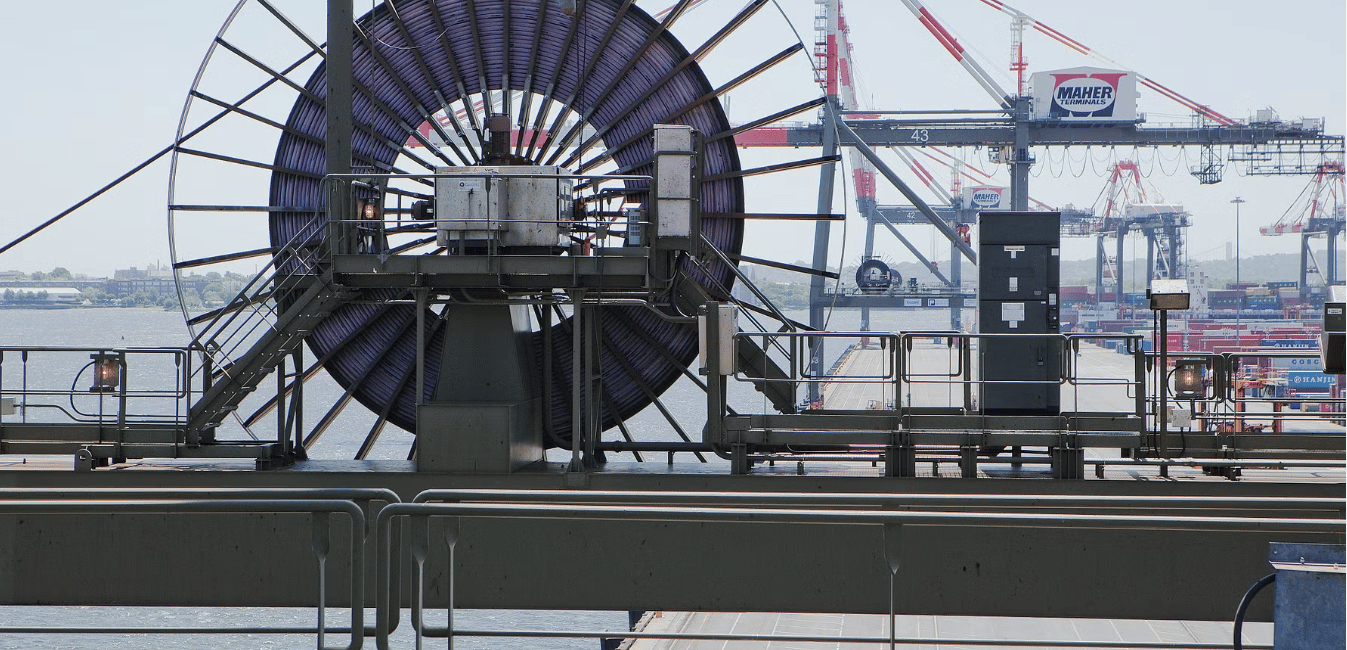

Mechanical and Electrical Advantages for Crane Use
The Type R-(N)TSCGEWOEU-FO cable incorporates several critical design features that make it exceptionally well-suited for demanding crane applications. The torsion-resistant design specifically addresses the complex mechanical stresses encountered in drum reeling applications, where cables must simultaneously handle bending, twisting, and tensile forces as they wind and unwind from cable reels.
High abrasion resistance ensures extended service life in port environments where cables may contact steel structures, experience wind-blown debris, or encounter rough handling during maintenance operations. The specialized outer jacket material resists cutting and gouging while maintaining flexibility, reducing the risk of catastrophic cable failure due to mechanical damage.
Oil resistance capabilities are particularly important in marine and port environments where hydraulic fluids, lubricants, and fuel oils are commonly present. The cable's chemical-resistant design prevents degradation of insulation and jacket materials when exposed to these substances, maintaining electrical integrity and mechanical strength over extended service periods.
EMC (electromagnetic compatibility) shielding represents another critical advantage for crane applications. The tinned copper shielding system provides effective protection against electromagnetic interference from nearby electrical equipment while preventing the cable from generating its own electromagnetic emissions. This dual protection ensures reliable operation of sensitive control systems and compliance with international EMC standards.
The cable's design also incorporates features to handle the unique mechanical stresses of reeling applications. Special strand configurations minimize work hardening, while optimized insulation and jacket materials maintain flexibility through millions of flex cycles. These design elements work together to provide exceptional fatigue resistance and extended service life.
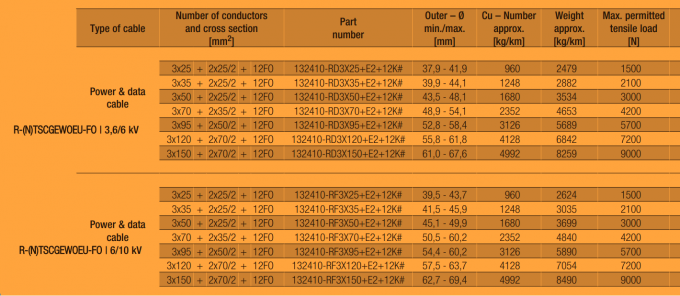


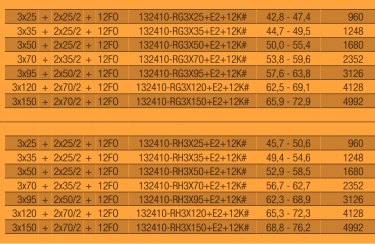
Port Crane Use Cases: Real-World Applications
Ship unloader reeling systems represent one of the most demanding applications for reeling crane cables. These massive machines operate continuously, moving thousands of tons of bulk materials from ships to shore-based storage facilities. The Type R-(N)TSCGEWOEU-FO cable's robust construction and integrated fiber optics support the precise control required for efficient unloading operations while withstanding the harsh marine environment.
In ship unloader applications, the cable must handle not only the electrical power requirements for drive motors and hydraulic systems but also the sophisticated control signals needed for automated positioning, load monitoring, and safety systems. The integrated fiber optics provide the high-speed, interference-free communication necessary for coordinated movements and real-time feedback from sensors throughout the unloader system.
Stacker and reclaimer systems in port terminals present similar challenges with additional complexity from dust, wind, and varying weather conditions. These systems require cables that can maintain performance while exposed to coal dust, iron ore particles, and other abrasive materials. The Type R-(N)TSCGEWOEU-FO cable's specialized jacket material and sealing systems provide effective protection against these environmental hazards.
Container crane cable drums represent another critical application where reliability directly impacts port productivity. Modern container cranes handle hundreds of containers daily, requiring precise positioning and rapid operational cycles. Cable failures in these applications can shut down entire berths, creating significant economic impacts. The Type R-(N)TSCGEWOEU-FO cable's proven reliability and extended service life make it an ideal choice for these mission-critical applications.
The cable's maximum travel speed capability of 120 m/min horizontally matches the operational requirements of modern high-speed port cranes, ensuring it won't become a limiting factor in crane performance. This speed capability, combined with the cable's mechanical durability, supports the rapid operational cycles required for competitive port operations.
Compliance & Standards
Compliance with international standards is crucial for port crane cables, ensuring safety, reliability, and compatibility with global port operations. The Type R-(N)TSCGEWOEU-FO cable meets VDE 0250 Part 814 requirements, which specifically address trailing cables for mobile equipment. This certification ensures the cable meets rigorous testing standards for mechanical durability, electrical performance, and environmental resistance.
VDE 0250 Part 813/814 compliance indicates the cable has undergone extensive testing for flexing endurance, demonstrating its ability to withstand millions of flex cycles without degradation. These standards also verify the cable's performance under various environmental conditions, including temperature extremes, moisture exposure, and chemical resistance.
DIN (Deutsches Institut für Normung) standards provide additional verification of the cable's construction quality and performance characteristics. These standards ensure consistent manufacturing processes and material specifications, providing confidence in long-term reliability and performance.
IEC (International Electrotechnical Commission) standards ensure global compatibility and safety compliance. IEC 60332-1 flame retardant certification confirms the cable's fire safety characteristics, an important consideration in port environments where fire prevention is critical for personnel safety and asset protection.
International port operation standards, including those established by major port authorities and shipping organizations, recognize the importance of certified cable systems for maintaining operational safety and reliability. The Type R-(N)TSCGEWOEU-FO cable's compliance with these standards ensures acceptance in ports worldwide.
The cable also meets specific requirements for marine environments, including resistance to salt spray, moisture ingress, and UV exposure. These certifications are backed by rigorous testing protocols that simulate years of operational exposure in accelerated timeframes.

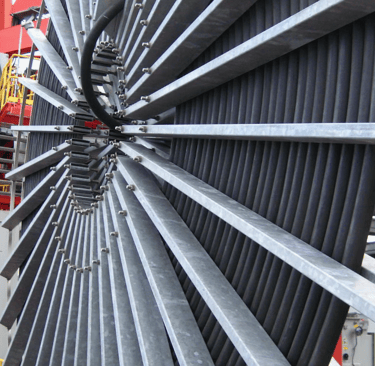
Why Choose R-(N)TSCGEWOEU-FO for Port Reeling Systems?
The enhanced lifespan under dynamic stress represents one of the most compelling reasons to choose the Type R-(N)TSCGEWOEU-FO cable for port reeling systems. Traditional cables often fail prematurely due to the constant mechanical stress of reeling operations, requiring frequent replacements that disrupt port operations and increase maintenance costs. This advanced cable system's specialized construction materials and design features significantly extend service life, reducing total cost of ownership.
The combined power and data transmission capability in one ruggedized design eliminates the complexity and potential failure points associated with multiple cable systems. This integration simplifies installation, reduces maintenance requirements, and improves system reliability. The space savings achieved by using a single cable also simplifies cable management systems and reduces the overall weight load on crane structures.
Maintenance and installation flexibility represent additional advantages that make this cable system particularly attractive for port operations. The cable's robust construction reduces the frequency of maintenance interventions, while its flexible design simplifies installation in complex routing situations. When maintenance is required, the integrated design means technicians only need to work with a single cable system rather than coordinating multiple power and communication cables.
The cable's proven performance in demanding applications provides confidence for port operators who cannot afford unexpected downtime. With operational capabilities including travel speeds up to 120 m/min and mechanical load-bearing capacity of 1350N, the cable supports the full performance envelope of modern port cranes without compromise.
Environmental resistance to salt spray, temperature extremes, and chemical exposure ensures reliable operation throughout the cable's service life, even in the harsh conditions typical of port environments. This reliability translates directly to improved port productivity and reduced operational risk.
Frequently Asked Questions
Q: What makes the Type R-(N)TSCGEWOEU-FO cable suitable for marine environments?
A: The cable features specialized insulation and jacketing materials designed to resist salt spray, moisture ingress, and UV exposure. The tinned copper conductors provide additional corrosion resistance, while the overall construction meets marine environment standards for long-term reliability.
Q: How does the integrated fiber optic system improve crane operations?
A: Integrated fiber optics provide high-speed, interference-free communication for real-time control system feedback, position monitoring, and diagnostic data. This eliminates the need for separate communication cables while providing superior signal quality compared to copper-based systems.
Q: What is the expected service life of this cable in typical port crane applications?
A: While service life depends on specific operating conditions, the cable's advanced materials and construction typically provide 2-3 times longer service life compared to conventional reeling cables, with many installations exceeding 10 years of continuous operation.
Q: Can this cable handle emergency stop and safety system signals?
A: Yes, the cable's design supports both power transmission and critical safety signals through its integrated fiber optic elements, ensuring reliable emergency stop and safety system operation even in harsh electromagnetic environments.
Q: What installation considerations are unique to this cable type?
A: The cable requires proper bend radius management and appropriate cable reel design to maximize service life. Installation should follow manufacturer guidelines for minimum bend radius and proper strain relief to ensure optimal performance.
The Type R-(N)TSCGEWOEU-FO reeling crane cable represents the pinnacle of modern cable technology for port and harbor applications. Its combination of robust mechanical construction, integrated fiber optic communication, and proven environmental resistance makes it the optimal choice for operators seeking maximum reliability and performance in their critical crane systems.
How to Reach Us
Get in Touch
SiteMap
Product Catalogue
Reeling Cable
Festoon Cable
Shore Power Cable




Scan to add us on WeChat
